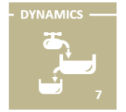Objectives - ¨Business Rationale¨ 
(A matter of ends)

The Objectives: why the Processes are performed (for what reason and to what purpose), in the frame of the current and future Business Phases.
Defining the Objectives of the Business Activity is defining the "Business Rationale" for the associated Business Phase: determining, for each major process:
- Output objectives: Objectives related to the expected value generated by the Process, either in terms of level (expected quantity and quality) or in terms of expected flow rate.
- Operating objectives: Objectives related to the required value used by the Process (supplies and resources), either in terms of level (required quantity and quality) or in terms of required flow rate.

The ¨Business Rationale¨ is to be considered in term of Business Phases: Output objectives and Operating objectives are set for the current Business Phase:
- as the purpose of the current Business Phase,
- or as the reason specifically related to what is needed before switching to the following Business Phase,
Objectives are associated with each Super-Process and can therefore be split in 3 categories:
- Market Objectives: Objectives related to Value Generation & Delivery (VG&D)
- Capture Objectives: Objectives related to Value Contracting & Capture (VC&C)
- Industry Objectives: Objectives related to Value Integration & Maintenance (VI&M)
(click on the following elements for more details)
> Market Objectives
(Objectives for VG&D)
Output Objectives:
Market Output Objectives are objectives assigned to the output of Market Processes: Products (in an extended sense). Those outputs are often tied to Capture Processes (ex: delivery of goods as a result of customers’ orders), therefore objectives should be attributed to the Super-Process they actually depend on.
- A Toyota factory may have objectives in terms of production rate and production quality, after switching to a new configuration with additional lines,
- After it improved its delivery organization, Cemex set objectives in terms of cement delivery lead time,
- Facebook may have had an objective in terms of number and size of marketing campaigns to gain its user base, before reaching a critical size and starting monetizing it,
- So long as it keeps its current activity, an online magazine like Techcrunch may have objectives in terms of number of articles released per day.
Operating Objectives:
Market Operating Objectives are objectives assigned to Market Processes in terms of requirement levels regarding inputs (Supplies and Resources) and inputs’ usage.
- Smart (Daimler AG) has objectives in terms of bill of materials (BOM) for its cars, i.e. objectives in terms of quantity of supplies directly incorporated into the product,
- Southwest Airlines has objectives in terms of average fuel consumption for its flights, i.e. objectives in terms of quantity of supplies directly consumed in the service delivery process,
- Airbus has objectives in terms of lead-time to build each plane, i.e. objectives in terms of manufacturing resources usage rate for its production process,
- Samsung will have objectives in terms of required usage of rare earth materials when it switches to a manufacturing process using substitutes,
- switching to LTE (4G) network, Verizon has objectives in terms of required infrastructure to serve a given number of clients.
> Capture Objectives
(Objectives for VC&C)
CAPTURE ON CUSTOMERS’ SIDE:
Output Objectives:
Capture Output Objectives (on Customers’side) are objectives assigned to the output of Capture Processes: Revenues.- Rovio, editor of Angry Birds, may have had objectives in terms or monthly revenue before extending its business to derivate products,
- Pebble Technology, a smartwatch company, had objectives in terms of number of preorders on Kickstarter before starting its production phase,
- a VC fund has objectives in terms of money raised before switching to the investment phase, and objectives in terms of portfolio divestment before closing its activity,
- once their business activity is more or less settled, most organizations have, of course, objectives in terms of annual revenues.
Operations Objectives:
Capture Operating Objectives (on Customers’ side) are objectives assigned to Capture Processes in terms of requirement levels regarding inputs (Supplies and Resources, but also Products – see Business Functions as BUs) and inputs’ usage.- SAP has objectives in terms of sales cycle time, i.e. objectives in terms of required sales representatives’ time for its sales process,
- with its online stores, Zara (Inditex) may have objectives in terms of required physical stores to ensure its sales,
- Disneyland has objectives in terms of required advertising to get new customers visiting its park (leading to “customer acquisition cost”),
- by switching to a “cashless” payment solutions, vending machine operators like Canteen Vending Services have objectives in terms of required logistics to collect coins,
- Comcast has objectives in terms of required channels (generally speaking, a “product bundle”) to ensure a given level of revenue per customer.
CAPTURE ON SOURCES’ SIDE:
Output Objectives:
Capture Output Objectives (on Sources’ side) are objectives assigned to the output of Capture Processes: Supplies.
- Any Century 21 agency has objectives in terms of new reselling contracts per month, from real estate owners,
- Cash for Gold Co has objectives in terms of new individual gold suppliers per month,
- a VC fund has objectives in terms of startups to invest in during the investment phase of its business activity,
- Bank of America has objectives in terms of companies’ financial profile when it lends money (i.e. when it buys debt),
- Bolloré Group had objectives in terms of lithium sourcing before beginning its electric vehicle manufacturing phase.
Operations Objectives:
Capture Operating Objectives (on Sources’ side) are objectives assigned to Capture Processes in terms of requirement levels regarding inputs (Supplies and Resources, but also Cash – see Business Functions as BUs) and inputs’ usage.- for its current business activity, Groupon must have objectives in terms of required sales executives to reach a given level of merchant acquisition rate,
- focusing on the efficiency of its purchasing process, Walmart must have objectives in terms of required IT and HR infrastructure,
- most organization should have, of course, objectives in terms of cost for what they have to buy, i.e. objectives in terms of required cash to acquire a given type of supplies.
> Industry Objectives
(Objectives for VI&M)
Output Objectives:
Industry Output Objectives are objectives assigned to the output of Capture Processes: Resources.
- A new Samsung plant has objectives in terms of manufacturing infrastructure, before it switches to the production phase,
- Tesla Motors must have objectives in terms of new high end models it will develop before switching to mass produced models aimed at the mainstream,
- a League 2 soccer team has objectives in terms of victories before it can switch to a new business phase heavily focused on sponsorship-based revenues,
- 20 Century Fox has objectives in terms of films produced per year,
- Microsoft may have objectives in terms of new patents per year.
Operating Objectives:
Industry Operating Objectives are objectives assigned to Industry Processes in terms of requirement levels regarding inputs (Supplies and Resources) and inputs’ usage.- Google has objectives in terms of electricity consumption to run its servers,
- with CAD solutions, mobile phones manufacturers were able to set stronger objectives in terms of required design process time,
- by adopting online training solutions, GE could set new objectives in terms of required infrastructure to improve the efficiency of its human resources,
- Aqua America, using sensors in its water delivery network, has objectives in terms of required on-site interventions for maintenance.
Processes < PREVIOUS - NEXT > Cycles









